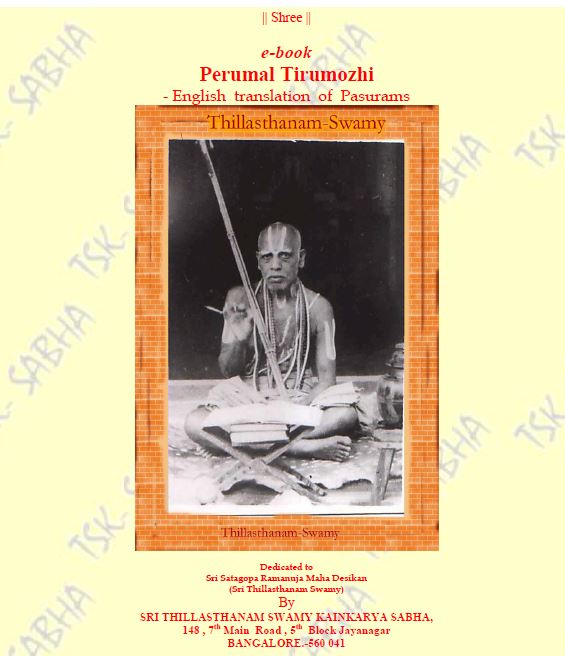Sri . Thillasthanam Swamy Kainkarya Sabha , Bangalore

- Home
- About
- Books Preview
- Gallery & Videos
- Downloads
- Swamy-Brindavanam Renovation
- Popular Info. , Slokas & Hymns
- Srivaishnavism & Saranagathi
- Sandhyavandandanam & Gayathri Japam
- Vedic Pranayamam
- Mantra Snanam
- Upanayanam
- Information-General
- Sabha News Board
- Query-Form & Sabha Contacts
- Back Links-Admin
For the kind attention of Patrons & Devotees : We now have a updated and new version of the website with latest updates .
Please click on the link below to navigate to the same
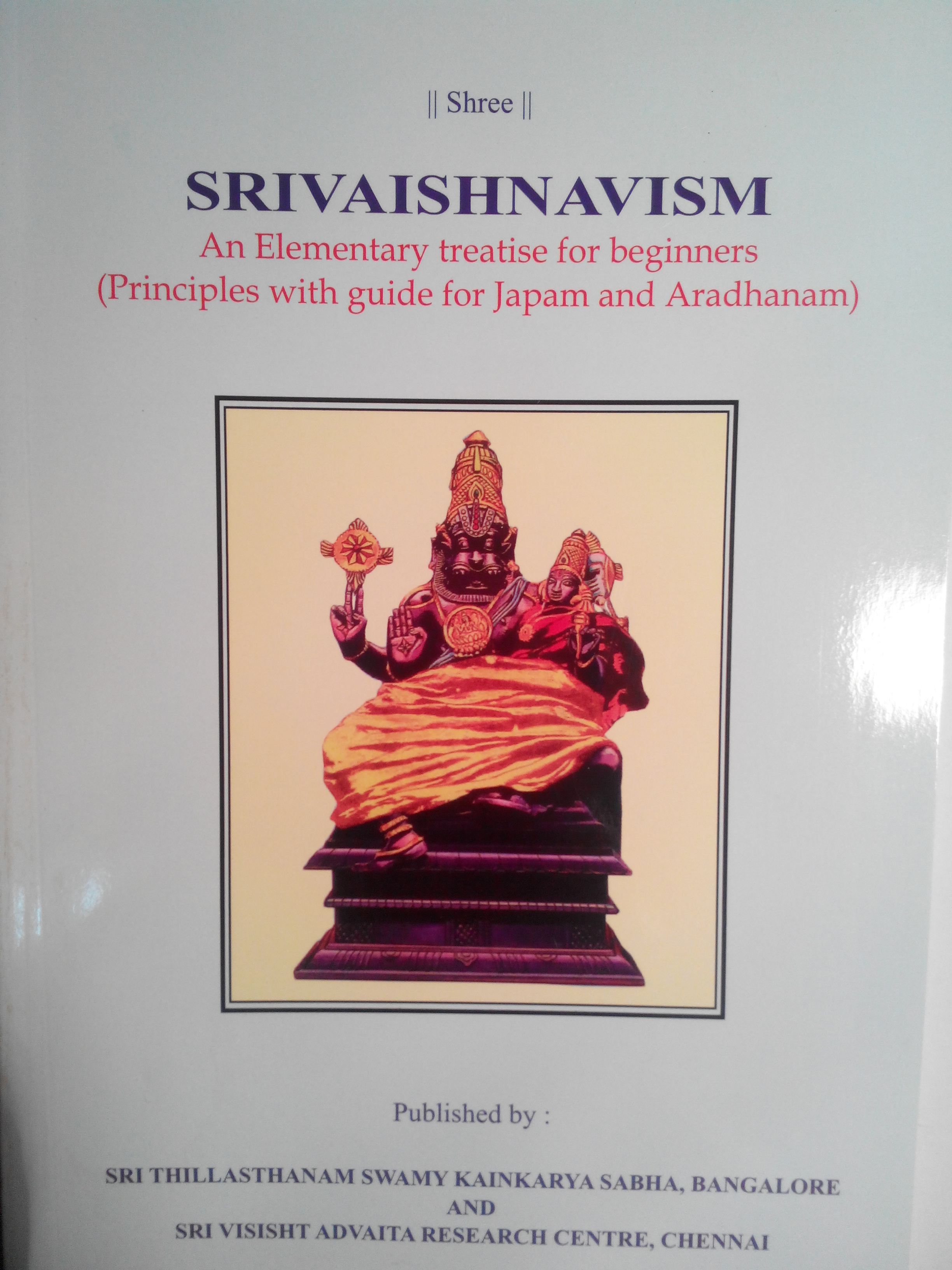
- Srivaishnavism book Preview :
- In regard to protection of individuals , Vedanta Desika says " Pradanahethuhu Swatantrya Vishitaa Karuna Hari " meaning Grace of God is the main factor . The question is how to get his Grace ?? Bhagwan Ramanuja has addressed this from the point of of view of ordinary people and has expounded the Saranagathi approach - basis of Srivaishnavism.
- With the advent of science ,vedic approach to universe is gaining recognition. Meditation is no longer considered a mere ritual.The vedic approach has been that our planet (Earth) is a part of the universe and the systems of the universe have influence on the life in our planet.The human beings have a major role to play in this regard. All vedic philosophies aim at this objective.
- Srivaishnavism aims to God -Realisation within the frame work of our normal worldly activities.This aspect has been effectively brought out in this book.This book brings out in a simple language the elements of Srivaishnavism for Layman , elaborating various points discussed under the subject of Srivaishnavism . The emphasis is on practical aspects as the main objective of Srivaishnavism is to earn the grace of the Lord by an individual .It is modelled as a self instructor for use by by persons who do not have much specialized knowledge.Starting from the the lineage of teachers ,the book discusses Tatwa Thraya (three realities) , Karmas , Forms of Eshwara , Pancha Samskara , Rahasya Thraya mantras , How to do Saranagathi , Path to Moksha etc .The book also discusses daily routine of a Srivaishnava . The daily routines have been simplified to a minimum level. It will enable a beginner to make a beginning in right earnest and gradually improve. Appendix-1 gives the daily meditation procedure and will help one to practice daily meditation. Appendix-2 gives a simplified version of Saligrama Aradhana . The presentation also covers a comparative study of Vedic approach and modern scientific researches .The examples and references to scientific studies including the ECG to assess the impact of Srivaishnava mantras on individuals and presentation has been such as to create an interest in an individual to follow the principles of Srivaishnavism.
- It is hoped that this book will create interest in a number of persons and help them to follow the path of Srivaishnavism.The book has been popular with those who want to practice the concepts of Srivaishnavism and elevate one's personality. Presentation of this book as a gift on various occasions is also common . The book is nominally priced at Rs 50/- in India and US $ 5 abroad . Copies are available with Sri Thillasthanam Swamy Kainkarya Sabha , e-Mail : tsksabha@yahoo.com or tsksabha@thillasthanam-swamy-sabha.in
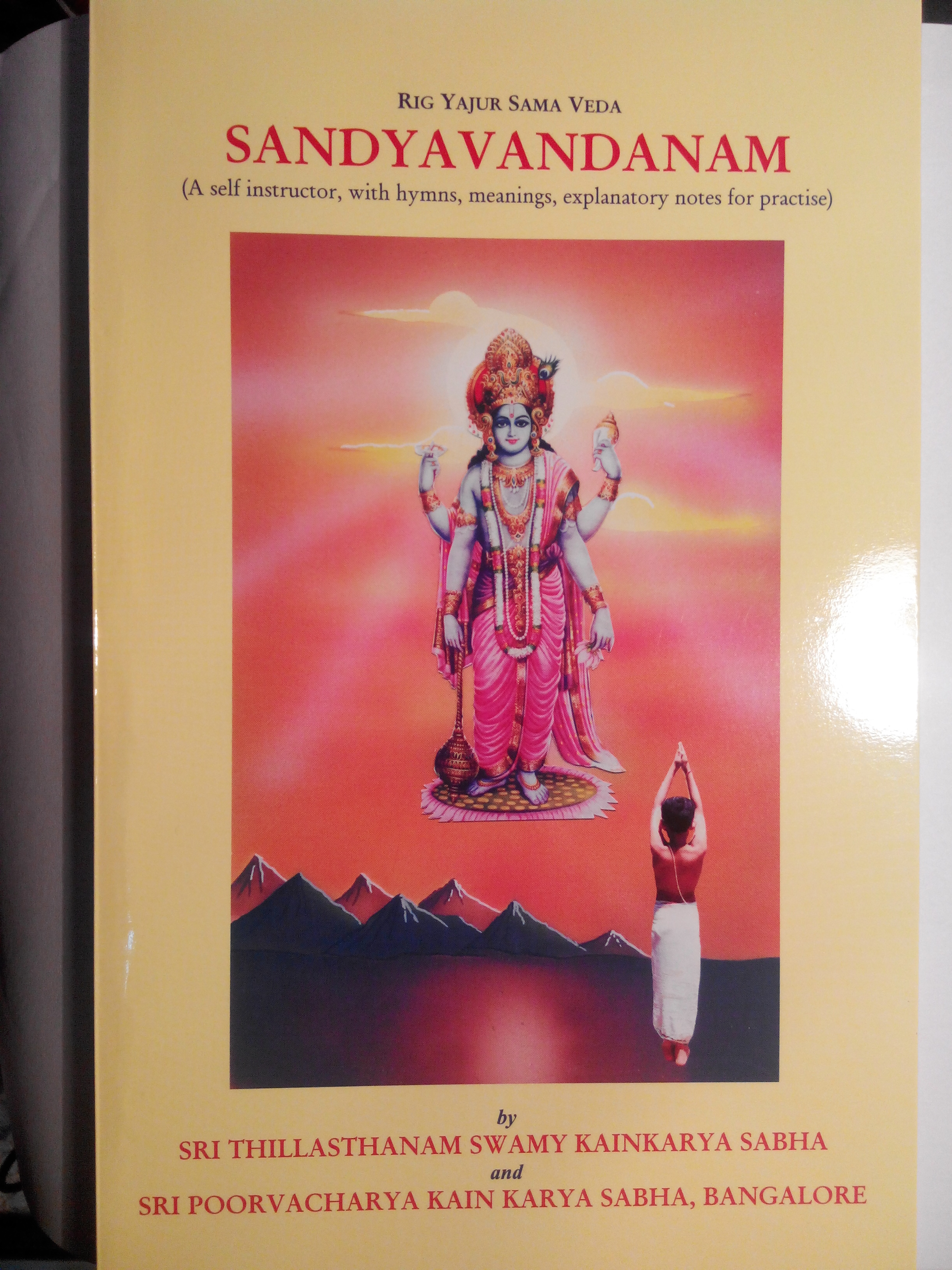
- Sandhyavandanam Book Preview
- A number of individuals after the success of the book on Srivaishnavism requested the sabha to bring out a book on Sandhyavandanam .
- Great Sages like Manu , Parasara , Yagnavalka , Gautama and others , with a view to establish a society of nobility , have prescribed a few Samskaras or rituals. These Samskaras are integral part of Hindu Dharma and are meant to improve the quality of humans. Sandhyavandanam is one such Samskara and is meant to improve the health of body and mind and also improve intellectual quality. It is a 'Nitya Karma' or daily ritual to be performed at 'Sunrise' and 'Sunset' . Vedic tenets recognise an energy body external to our physical body.This acts as a via media between the individual and the universe. Cosmic radiations are absorbed through chakras in this energy body.
- Sandhyavandanam or Sandhya prayers consists of (a) Purification (b) Offering Arghyam (c) Meditation through Gayathri . By purification , it is meant to condition ourselves to receive cosmic radiation and not just superficial cleaning.
- A statement by our sages states : 'Sandhyahino Ashuchih Nityam Anarhah Sarva Karmasu . Yada Anyat Kurute Karma Na Tatra Phalam Ashnute ' meaning one who does not perform Sandhyavandanam is ever impure and as such not qualified to perform any religious act. Inspite of this if he performs any religious act , there will be no benefits. This illustrates the importance given to Sandhya Prayers in our tradition.
- The book has been brought out as a A self instructor type with meanings , explanatory notes to meet the needs of the present generation. Thus , one can perform Sandhyavandanam with understanding . The book has been organised as under :
- Chapter -I is devoted to general information and covers Vedic tenets , significance and time of performance of Sandhyavandanam and a few scientific facts.
- Chapter-II is devoted completely to various rituals forming part of Sandhyavandanam.Not only correct performance of the rituals have been explained with photographs but also explanatory notes have been added to bring out the significance of the rituals.
- Chapter -III (Along with Annexures) is devoted to Hymns in the three Veda Sakas. Hymns have been given in Sanskrit ,Tamil and Kannada scipts for Yajur Veda to cover a wide range of people.Hyms for Rig and Sama Sakas are given in Devanagiri script .
- Chapter-IV covers meanings of important Hymns included in Sandhyavandanam.
- Chapter -V covers other important Vedic rituals. Rituals like "Yagnopavitha Dharanam " ( Changing of sacred thread) etc for the benifit of those residing at places where facilities of a teacher or guide are not easily available.
- Basically ,the conventional Vedic style of Sandhyavandanam has been followed in the book but the findings of modern science for better appreciation of the various rituals and the Hymns have been included in the book.The approach is that Sandhyavandanam should not be looked upon as a mere ritual but as a Vedic prescription for development of personality with healthy body and mind. The presentation in the whole book is from practical aspects , the objective being that every individual should avail the benefits of Sandhya periods.
- This book has proved a good success and many have even taken the book to present it to others on the occasion of " Upananynam" - Sacred thread ceremony.The book has been nominally priced at Rs 100/- in India and US$ 10 abroad .Copies are available at Sri.Thillasthanam Swamy Kainkarya Sabha , e-Mail tsksabha@yahoo.com or tsksabha@thillasthanam-swamy-sabha.in

Vedic Pranayamam - Book Preview
- Well wishers of the sabha after the success of the books on Srivaishnavism and Sandhyavandanam requested the sabha to bring out a book on the importance of Pranayamam . Accordingly , the book titled 'Vedic Pranayamam - An elixir for health and prosperity' was conceived.
- Great Sages like Manu , Parasara , Yagnavalka , Gautama and others , with a view to establish a society of nobility , have prescribed a few Samskaras or rituals. These Samskaras are integral part of Hindu Dharma and are meant to improve the quality of humans. Sandhyavandanam is one such Samskara and is meant to improve the health of body and mind and also improve intellectual quality. It is a 'Nitya Karma' or daily ritual to be performed at 'Sunrise' and 'Sunset' . Pranayamam is an integral part of Sandhyavandanam . Vedic tenets recognise an energy body external to our physical body.This acts as a via media between the individual and the universe. Cosmic radiations are absorbed through chakras in this energy body.
- The discussion in this book is limited to Vedic Pranayamam , taught at the time of Upanayanam and also forming part of Sandhyavandanam . Our sages have given a format for Pranayamam.this format is discussed in the light of research of human body through Kirlian Photography , brain studies etc. It will be seen from these discussions that the format for Pranayamam given by our sages is indeed unique and helps a great deal in preserving our physical health and also develop personality .
- Chapter-1 is a General Introduction and covers Respiration , Human body , Human brain , Nadis , Chakras and Sources of Energy.
- Chapter-2 discusses about various Mudras and Meditation and also the importance and benefits of the Mudra.
- Chapter-3 discusses about Vedic Pranayamam , Ashtakashara Pranayamam and also Agarbha Pranayamam
- Chapter-4 discusses about Pranayamam Mantra Japam and it's procedure. For benifitting various section of the society the procedure has been included in Devanagiri , Kannada and Tamil scripts. This section also includes a discussion on Vyahriti Mantra Japam.
- Chapter-5 covers briefly about Upanayanam and Sandhyavandanam , basically an excerpt from the sabha's publication ' Sandhyavandanam'
- Chapter-6 covers the Physical exercises like stretching the spinal cord and deep breathing or abdominal breathing basically to help the flow of energy all over the organs of the body.
- Chapter-7 covers Art of Living in today's deteriorating environment with a hectic life style . Certain prescriptive details are given to be followed by an individual based on the tenets of Srivaishnavism
- Chapter-8 is the conclusion and ends with the prayers to the Lord .
- This books on Sandhyavandanam and Srivaishnavism have proved a good success and many have even taken the book to present it to others on the occasion of " Upananynam" - Sacred thread ceremony. As a supplement for these books it is expected that the book on Vedic Pranayamam will also prove to be a big success . The book is nominally priced at Rs 50/- in India and US $ 5 abroad . Copies are available with Sri Thillasthanam Swamy Kainkarya Sabha , e-Mail : tsksabha@yahoo.com or tsksabha@thillasthanam-swamy-sabha.in

Vedic Approach to Healthy Living - Book Preview
- A good health is what everyone seeks. Our sages (rishis) have found that proper absorption of all pervading life energy (cosmic energy) is the key to health. Only input our body gets is the food intake. The body has to process this input to build necessary infrastructure for handling all human activities-both physical and mental. For doing this,the body needs motive power (very similar to electricity in industrial plants).This motive power is supplied by life energy. The absorption of motive power by the body is an involuntary process (that is, it takes place without any effort on our part). However, lifestyle, food habits and other acts, have influence on motive power. Hence, our sages prescribe some corrective measures, referred to as traditions (or Achara) etc. This booklet presents a few simple measures for healthy living. They may appear trivial but they have a great potential. This can be practiced by one and all. The whole exercise takes only a few minutes.
- The sabha feels that these measures are a must in the present day living conditions.
- This book also contains two addendums viz. " Vedic Ritual - Aposhanam - Significance " and " Why Darbha grass is used in Vedic Rituals "
- The book is nominally priced at Rs 50/- in India and US $ 5 abroad . Copies are available with Sri Thillasthanam Swamy Kainkarya Sabha , e-Mail : tsksabha@yahoo.com or tsksabha@thillasthanam-swamy-sabha.in
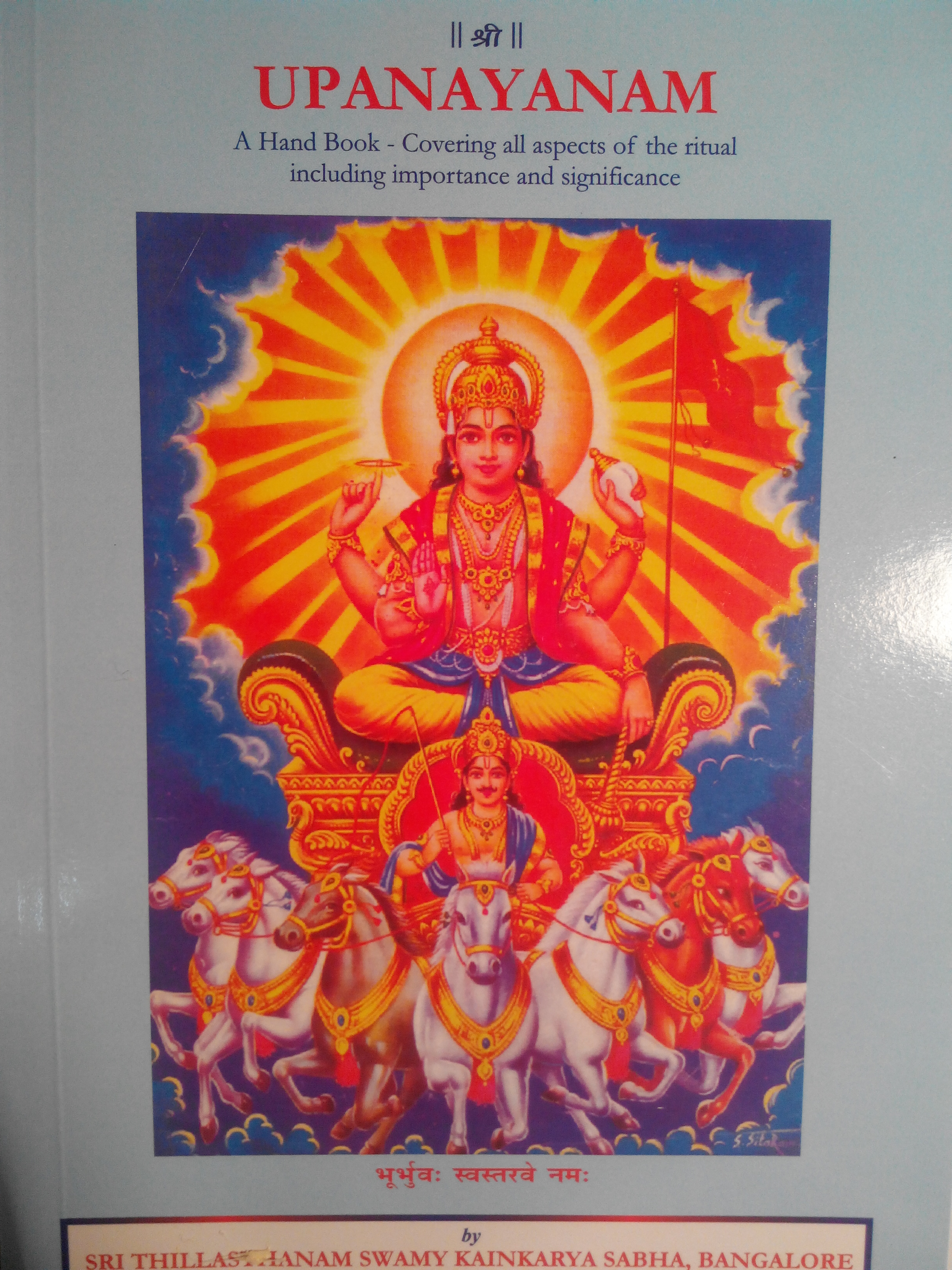
Upanayanam - Book Preview
- Well wishers of the sabha after the success of the books on Srivaishnavism , Sandhyavandanam and Vedic Pranayanam requested the sabha to bring out a small 4 page pamphlet for distribution during Upanayanam function which was very well received . The present book was conceived as an elaboration of the 4 page pamphlet in detail alongwith several other useful information brought together to serve the needs as a handbook for Upanayanam .
- Accordingly , the book titled 'Upanayanam ' was conceived and modelled as a handbook covering all aspects of the ritual including importance and significance.
- Great Sages like Manu , Parasara , Yagnavalka , Gautama and others , with a view to establish a society of nobility , have prescribed a few Samskaras or rituals. These Samskaras are integral part of Hindu Dharma and are meant to improve the quality of humans. Aksharabhyasa & Upanayanam are two such Samskaras devoted to education . Upanayanam means 'taken near' meaning that the boy is taken near a teacher for education. It is a Samskara to provide the boy with faculties to meet the change from childhood to boyhood.
- The discussion in this book covers all aspects of the ritual including importance and significance . The book is of aprox 80 pages covering comprehensively the Upanayanam ritual and serves as aa guide to those performing the ritual .After explaining the 'Suthras" on the subject the book discusses in detail (i) The preliminaries activities (ii) the main upanayanam ritual (iii) Post upanayanam activities .For better appreciation of the subject , appendices are included covering use of Panchangam , significance of Darbha grass , list of items required for upanayanam and a few exercises recomended .
- Chapter-1 is a General Introduction
- Chapter-2 discusses about various Suthras
- Chapter-3 discusses about Preliminary activities like selection of date and time (muhurtham) , invitation , Pandal in front of the house etc
- Chapter-4 discusses about the dais or mantap , Udakashanti ,Palighe ,Raksha Kankana l , Nandhi and then about the main Upanayanam ritual.
- Chapter-5 covers the Post Upanayanam activities with stress on Sandhyavandanam , Gayathri Japam etc
- Chapter-6 is the Conclusion . For better appreciation some Appendices have been introduced .
- Appendix-1 covers a guide to use Panchangam
- Appendix-2 covers Kolam or Rangoli .
- Appendix-3 covers Dharbha ( Kusa or holy grass )
- Appendix-4 covers the list of items required for Upanayanam
- Appendix -5 covers some physical exercises that are recommended like Stretching of Spinal Cord ,Deep breathing or Diaphragmatic breathing ,Cleaning of respiratory track Massage of feet during feet cleansing
- This books on Sandhyavandanam , Vedic Pranayamam and Srivaishnavism have proved a good success and many have even taken the book to present it to others on the occasion of " Upananynam" - Sacred thread ceremony. As a supplement for these books it is expected that the above book on Upanayanam will also prove to be a big success . The book is nominally priced at Rs 50/- in India and US$ 5 abroad. Copies available at Sri.Thillasthanam Swamy Kainkarya Sabha , e-Mail : tsksabha@yahoo.com or tsksabha@thillasthanam-swamy-sabha.in
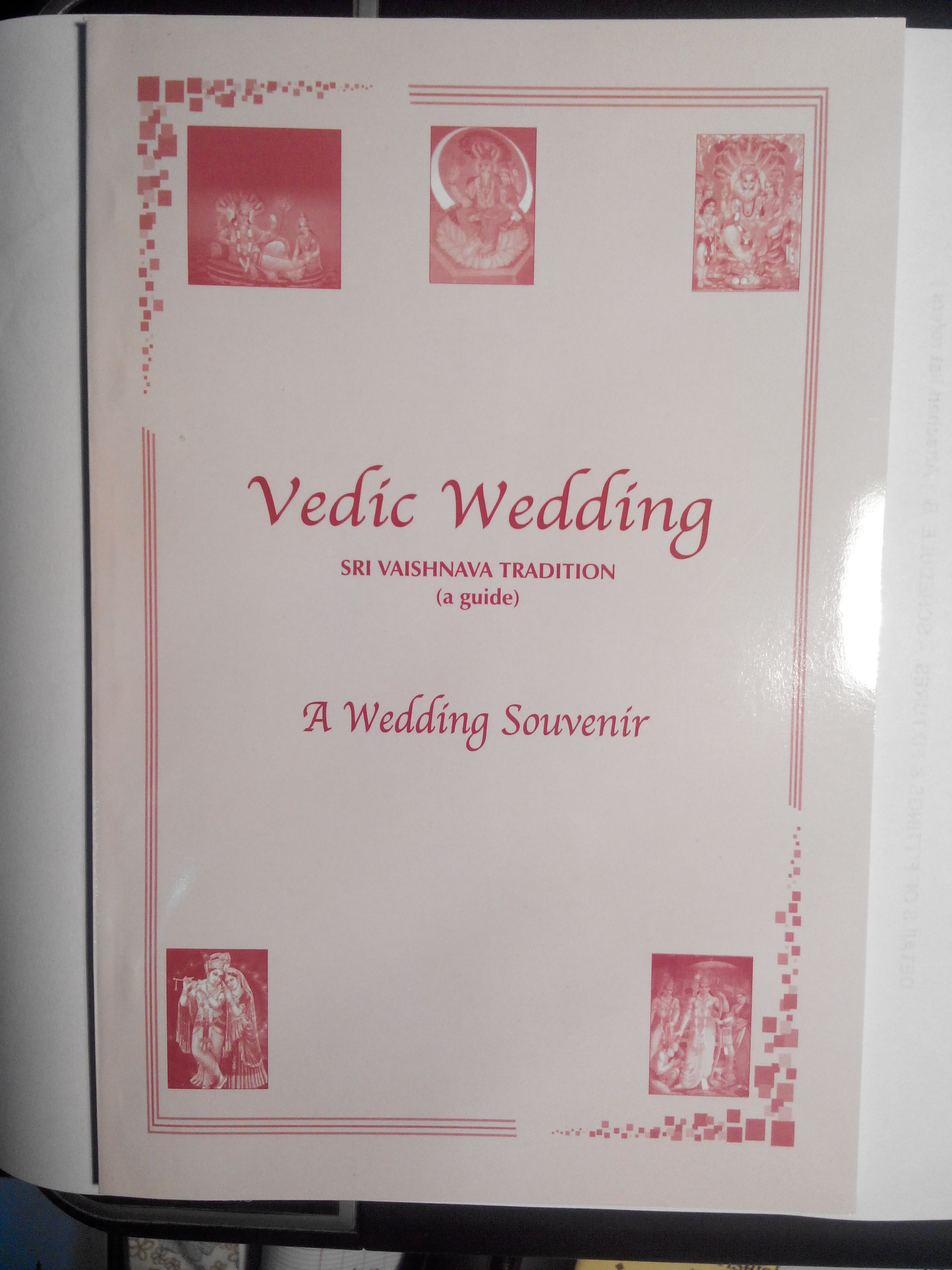
Vedic Wedding ( Sri Vaishnava Tradition ) - A Guide & Wedding Souvenir - Book Preview
- Vedic weddings are colourful and wears festive look. Srivaishnava weddings in addition add serenity to the wedding - bride dressed as ‘Andal’ and groom dressed as ‘Narayana’. Vedic weddings are not just restricted to external appearance. The rituals incorporate powerful veda mantras that have great impact on the individuals. This souvenir discusses in depth Srivaishnava vedic weddings.
- Chapter 1 discusses vedic concepts of human anatomy, concept of marriage, format, power of mantras and homam.
- Chapter 2 discusses the approach in the selection of bride and groom, time and date of marriage, etc.
- Chapter 3 discusses activities before wedding such as lagna patrika, invitation, arrangements, etc.
- Chapter 4 discusses the rituals on the marriage day such as vratam, jatakarma, ceremonial breakfast, Kasiyatra, exchanging of garlands, swing ceremony, etc.
- Chapter 5 discuss the main marriage ritual starting from kanyadanam and upto Lajja homam.
- Chapter 6 discusses post marriage rituals such as grihapravesham, pravishya homam etc and also traditional form of concluding vedic rituals.
- Chapter 7 summaries whole process and importance of main marriage ritual. Main marriage ritual incorporates powerful veda mantras and homams, particularly the lajja homam. It helps to bring divine grace and blessings not only for the young couple but also for society at large (prosperityof kalyana mantaps proves this point) .
- In the preparation of this souvenir, we have taken help form the following: “Samskara Maha dadihi” by Dr. Prof. A Ananta Narasimhachar “Yajusha Purva Prayoghna” by S. M. Krishnamachar “Hindu Samskaragalu” by Dr. T. V. Satyanarayana. “Lakshmi Kalayana Vaibhogam” by Nrisimhapriya “Upanayanam” and “Vedic Approach for healthy living” by Sri Thillasthanam Swamy Kainkarya Sabha .
- Most importantly we would like to express our gratitude for the Rishis who have given vedamantras for vedic weddings through this souvenir.
- We earnestly hope that this book will serve as a souvenir . The book is nominally priced at Rs 50/- in India and US$ 5 abroad. Copies available at Sri.Thillasthanam Swamy Kainkarya Sabha , e-Mail : tsksabha@yahoo.com or tsksabha@thillasthanam-swamy-sabha.in

Vedic Rituals - Their Relevance Today
This Pamphlet is compilation based on the lecture given by (Late) Sri . V.R.Narasimhan Iyengar , Hon President of Sri Thillasthanam Swamy Kainkarya Sabha , at the Indian Institute of World Culture on Aug 5th , 2012 on the occasion of ( Late )Mannargudi Prof . V. Gopalaswamy Iyengar memorial lecture organised by the Sri Ramakrishna Students Home on the founder's day in association with the Indian Institute of World Culture . This is for free distribution alongwith books purchased .
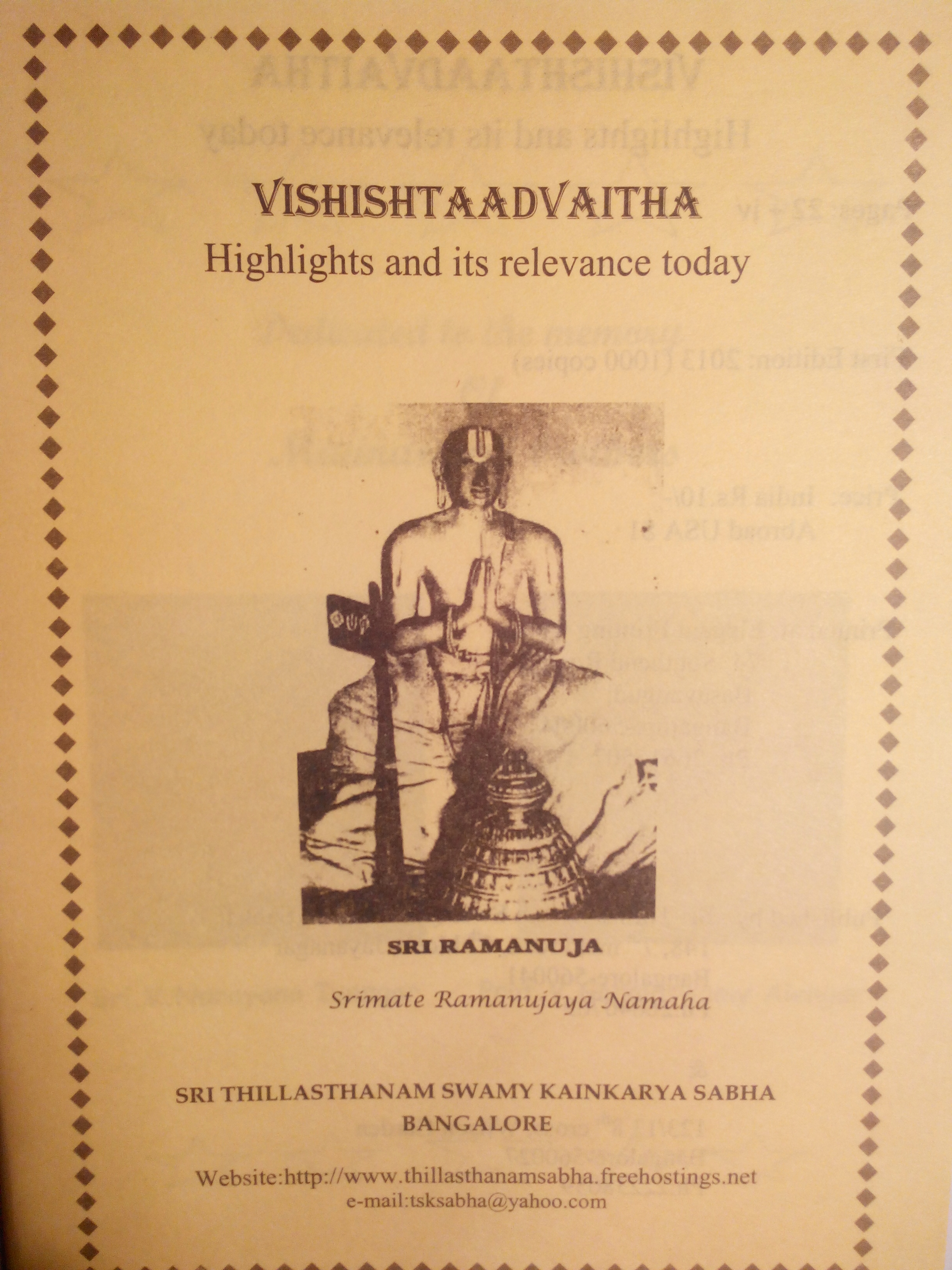
VishiShtaadvaitha -Highlights and its relevance today - Book Preview
- This small booklet of 22 pages was brought out as an add on with some additional information on the earlier book by the sabha on Srivaishnavism . This book is dedicated to the memory of the Late Mannargudi brothers Sri. V Narayana Iyengar and Prof Sri. V. Gopalaswamy Iyengar .
- The exact origin of Srivaishnavism is not known clearly. Followers of this tradition consider Lord Sriman Narayana as their supreme teacher and surrender to him totally. The story of Prahlada proves the existence of this tradition in Krita yuga. Now Alwars (of Dwapara and Kali yugas) are recognized as promoter of this cult. It remained as such till Ramanuja (20th Cent.), gave scientific explanation quoting vedic references. Srivaishnava cult after Ramanuja is known as VishiShtaadvaita.
- The “Principle of Surrender to God” or SHARANAAGATHI, is the central theme of VishiShtaadvaita, In various sections of this book we can see what this principle tells us about the man-God relation. The book has been organised under the following chapters .
- 1.0 INTRODUCTION 2.0 MAN GOD RELATION 3.0 SHARANAAGATHI AND ITS IMPACT ON HUMAN LIFE CYCLES 3.1 FORMS OF SHARANAAGATHI 3.2 PANCHASAMSKARA AND SRIVAISHNAVA MANTRAS 4.0 FORMS OF ISHWARA (GOD) 5.0 ALWARS AS THE PROMOTERS OF SRIVAISHNAVA CULT 5.1 DIVYAPRABANDHAM 6.0 GURUPARAMPARA 7.0 RAMANUJA’S FAREWELL MESSAGE 8.0 VISHISHTAADVAITHA’S RELEVANCE TODAY 9.0 CONCLUSION
- The book is nominally priced at Rs 50/- in India and US$ 5 abroad. Copies available at Sri.Thillasthanam Swamy Kainkarya Sabha , e-Mail : tsksabha@yahoo.com or tsksabha@thillasthanam-swamy-sabha.in
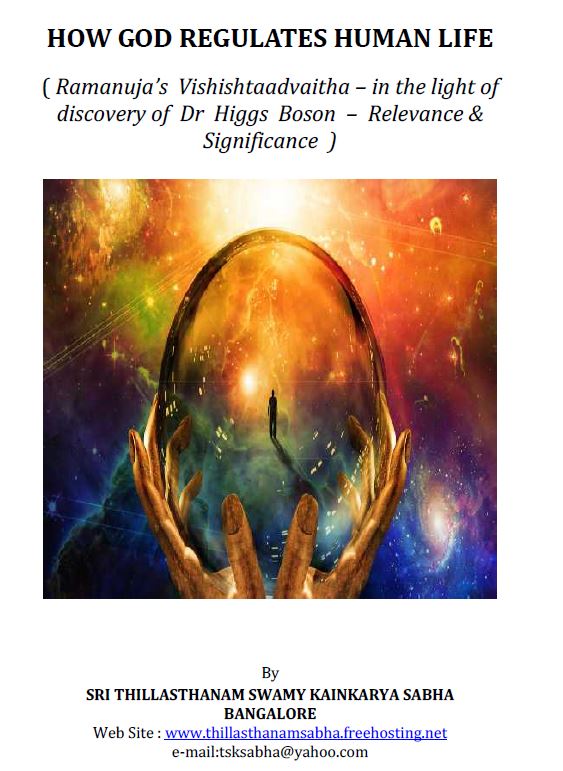
HOW GOD REGULATES HUMAN LIFE ( Ramanuja’s Vishishtaadvaitha – in the light of discovery of Dr Higgs Boson – Relevance & Significance )
This is a recent publication 12 pages is dedicated to Sri Ramanuja Charya and available only in ebook form . The purpose of this booklet is to correlate ancient concept with modern scientific knowledge for betterment of humanity . The book has been organised under the following chapters .
1.0 INTRODUCTION 2.0 RAMANUJA’S CONCEPT OF LIFE & UNIVERSE
3.0 SOURCES OF ENERGY FOR HUMANS 4.0 SARANAGATHI
4.1 RAMANUJA’s EXPLANATION 4.2 BIO ELECTRICITY 4.3 ENERGY MIX
4.4 INFLUENCE OF MEDITATION ON BIO ELECTRICITY
5.0 TIME OF MEDITATION 6.0 OTHER BENEFICIAL RITUALS 7.0 IMPORTANCE OF BODY ENERGY REGULATION 8.0 EFFECT OF UNREGULATED ENERGY 9.0 REFERENCE 10.0 CONCLUSION
This ebook is available in our FREE
download section.

